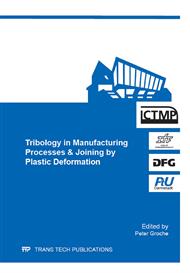[1]
H. Chandrasekaran and R. M'Saoubi, 2006, Improved machinability in hard milling and strategies for steel development, vol. 55, no. 1, 93-96.
DOI: 10.1016/s0007-8506(07)60374-6
Google Scholar
[2]
G. Nicola, F. P. Missell, and R. P. Zeilmann, 2010, Surface quality in milling of hardened H13 steel, Int J Adv Manuf Technol, vol. 49: 53–62.
DOI: 10.1007/s00170-009-2382-3
Google Scholar
[3]
Z. Tongchao Ding, Z. Song, Y. Wang, and Xiaoli, 2010, Empirical models and optimal cutting parameters for cutting forces and surface roughness in hard milling of AISI H13 steel, Int J Adv Manuf Technol, vol. 51: 45–55.
DOI: 10.1007/s00170-010-2598-2
Google Scholar
[4]
A. J. de Oliveira and A. E. Dinizb, 2009, Tool life and tool wear in the semi-finish milling of inclined surfaces, Journal of Materials Processing Technology, vol. 209: 5448–5455.
DOI: 10.1016/j.jmatprotec.2009.04.022
Google Scholar
[5]
L. Ning, S. C. Veldhuis, and K. Yamamoto, 2008, Investigation of wear behavior and chip formation for cutting tools with nano-multilayered TiAlCrN/NbN PVD coating, International Journal of Machine Tools, vol. 48:. 656–665.
DOI: 10.1016/j.ijmachtools.2007.10.021
Google Scholar
[6]
S. D. Cristofaro, et al., 2012, High-speed micro-milling: Novel coatings for tool wear reduction, vol. 68, 16-20.
Google Scholar
[7]
J. Xiong, Z. Guoa, M. Yang, W. Wan, and G. Dong, 2013, Tool life and wear of WC–TiC–Co ultrafine cemented carbide during dry cutting of AISIH13 steel, Ceramics International, vol. 39, p.337–346.
DOI: 10.1016/j.ceramint.2012.06.031
Google Scholar
[8]
E. Dimla, 2000, Sensor signals for tool-wear monitoring in metal cutting operations—a review of methods, International journal of machine tools & manufacture, vol. 40, no. 8, pp.1073-1098.
DOI: 10.1016/s0890-6955(99)00122-4
Google Scholar
[9]
D. Zhang, S. Dai, Y. Han, and D. Chen, 1994, On-line monitoring of tool breakage using spindle current in milling, , Shanghai.
Google Scholar
[10]
M. Shiraishi, 1988, Scope of In-Process Measurement, Monitoring and Control Techniques in Machining Processes – Part 1: In Process Techniques for Tools, Precision engineering-journal of the american society for precision engineering, vol. 10, no. 4, pp.179-189.
DOI: 10.1016/0141-6359(88)90052-9
Google Scholar
[11]
A. Devillez, S. Lesko, and W. Mozer, 2004, Cutting tool crater wear measurement with white light interferometry, Wear, vol. 256, pp.56-65.
DOI: 10.1016/s0043-1648(03)00384-3
Google Scholar
[12]
P. N. Botsaris and J. A. Tsanakas, 2008, State of the art in methods applied to Tool Condition Monitoring (TCM) in unmanned machining operations: a review.
Google Scholar
[13]
E. Jantunen, 2002, A summary of methods applied to tool condition monitoring in drilling, International journal of machine tools & manufacture vol. 42, pp.997-1010.
DOI: 10.1016/s0890-6955(02)00040-8
Google Scholar
[14]
S. Qiang, S. Cheng, and K. Jing, 2009, Tool wear intelligence measure in cutting process based on HMM, Proceedings of the 2009 IEEE International Conference on Automation and Logistics, ICAL 2009 , pp.1563-1567.
DOI: 10.1109/ical.2009.5262708
Google Scholar
[15]
Z. Wang, Y. Zou, and F. Zhang, 2011, A machine vision approach to tool wear monitoring based on the image of workpiece surface texture, Advanced Materials Research, vol. 154-155, pp.412-416.
DOI: 10.4028/www.scientific.net/amr.154-155.412
Google Scholar
[16]
H. H. Shahabi, M. M. Ratnam, 2009, In-cycle monitoring of tool nose wear and surface roughness of turned parts using machine vision, Int J Adv Manuf Technol , vol. 40: 1148–1157.
DOI: 10.1007/s00170-008-1430-8
Google Scholar
[17]
K. Kubiak and T. Mathia, 2009, Influence of roughness on contact interface in fretting under dry and boundary lubricated sliding regimes, Wear, vol. 267, p.315–321.
DOI: 10.1016/j.wear.2009.02.011
Google Scholar
[18]
T. G. Mathia, P. Pawlus, and M. Wieczorowski, 2011, Recent trends in surface metrology, Wear, vol. 271, p.494–508.
DOI: 10.1016/j.wear.2010.06.001
Google Scholar
[19]
M. C. E. o. s. MatWeb. (2011) Matweb. [Online]. HYPERLINK http: /www. matweb. com/, http: /www. matweb. com.
Google Scholar
[20]
ISO, 1989, "Tool life testing in milling Part 2 - End milling.
Google Scholar
[21]
J. Brezinova and A. Guzanova, 2010, Friction Conditions during the Wear of Injection Mold Functional Parts in Contact with Polymer Composites, Journal of Reinforced Plastics and Composites, vol. 29, no. 11, pp.1712-1726.
DOI: 10.1177/0731684409341675
Google Scholar
[22]
M. Balcon, F. Marinello, S. Carmignato, and E. Savio, 2011, Wear analysis through surface relocation, Journal of Physics Conference Series, vol. 311.
DOI: 10.1088/1742-6596/311/1/012020
Google Scholar
[23]
Kubiak, K., Liskiewicz, T.W., Mathia, T.G., 2011, Surface morphology in engineering applications: Influence of roughness on sliding and wear in dry fretting., Tribology International, p. doi: 101016/jtriboint201104020.
DOI: 10.1016/j.triboint.2011.04.020
Google Scholar
[24]
Blanc, J.; Grime, D.; Blateyron, F., 2011, Surface characterization based upon significant topographic features, 13th international conference on metrology and properties of engineering surfaces, Journal of Physics Conference Series, vol. 311 no. 012014.
DOI: 10.1088/1742-6596/311/1/012014
Google Scholar
[25]
A. Pereira, et al., 2013, Study of morphology wear model of moulds from alloys of aluminium EN AW-6082 in injection process., Key Engineering Materials, vol. 554-557, no. doi: 10. 4028/www. scientific. net/KEM. 554-557. 844, pp.844-849.
DOI: 10.4028/www.scientific.net/kem.554-557.844
Google Scholar
[26]
A. Pereira, P. Hernández, J. Martinez, J. A. Pérez, and T. G. Mathia, 2014, Surface Topographic Characterization for Polyamide Composite Injection Molds Made of Aluminum and Copper Alloys., Scanning, vol. 36, pp.39-52.
DOI: 10.1002/sca.21083
Google Scholar
[27]
Y. Jenga and C. Gao, 2000, Changes of Surface Topography during Wear for Surfaces with Different Height Distributions, Tribology Transactions, vol. 43, pp.749-757.
DOI: 10.1080/10402000008982404
Google Scholar
[28]
J. Condeço, L. H. Christensen, and B. G. Rosén, 2001, Software relocation of 3D surface topography measurements, International Journal of Machine Tools and Manufacture, Elsevier Ltd vol. 41 no. 13-14, pp.2095-2101.
DOI: 10.1016/s0890-6955(01)00076-1
Google Scholar
[29]
K. Sasajima, K. Naoi, and T. Tsukada, 2000, A software-based relocation technique for surface asperity profiles and its application to calculate volume changes in running-in wear, Wear, 240, n 1-2, Elsevier S.A. : 152-163.
DOI: 10.1016/s0043-1648(00)00347-1
Google Scholar


